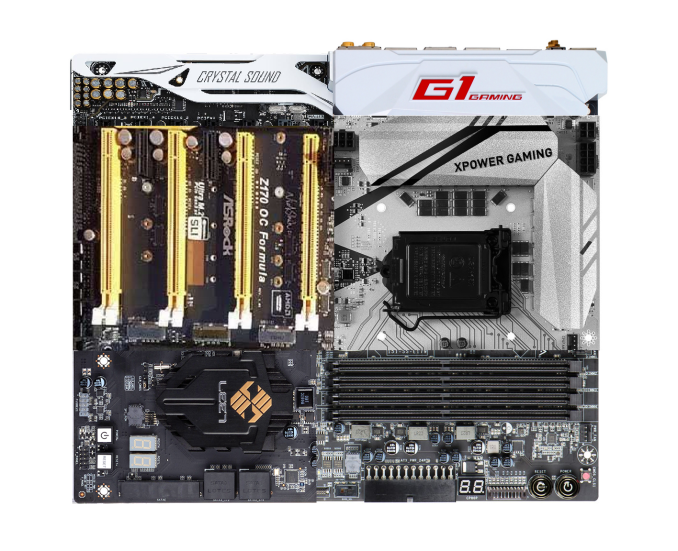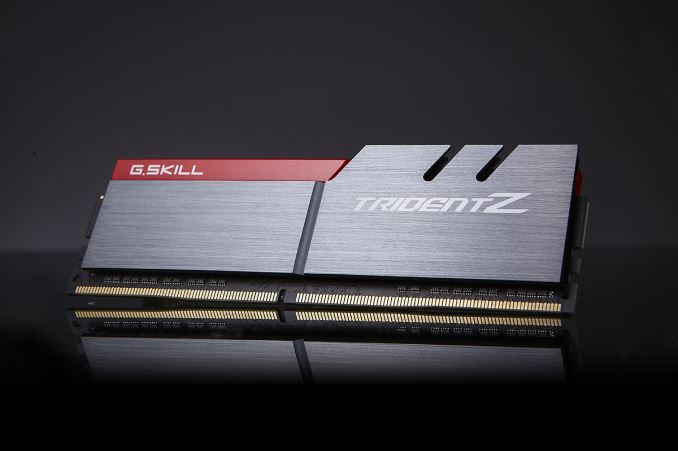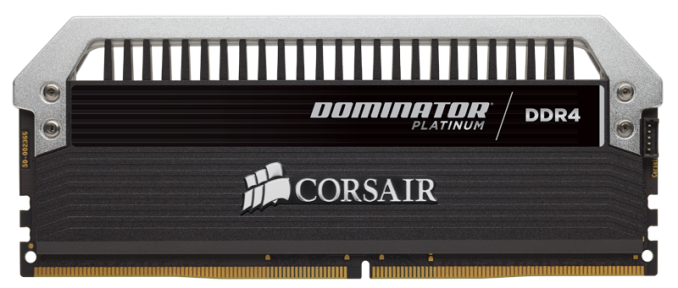The Intel 6th Gen Skylake Review: Core i7-6700K and i5-6600K Tested
by Ian Cutress on August 5, 2015 8:00 AM ESTAlso Launching Today: Z170 Motherboards, Dual Channel DDR4 Kits
The new Skylake processors are assigned a new socket – LGA1151. Intel’s policy since 2006 has been to maintain sockets for two generations and as a result moving from Broadwell to Skylake we were expecting the change. This means that Skylake processors will not work in LGA1150 based motherboards, i.e. those with Intel’s 8th and 9th generation chipsets. For Skylake we get the 100-series chipsets with additional functionality. Launching today in turn is the first member of the 100-series family, the overclocking-friendly Z170, with the other chipsets in the family to follow later in the year.
We have a large piece on the motherboards being released or talked about for Skylake, covering some 55+ products and the different variations within. The major motherboard manufacturers such as ASUS, GIGABYTE, ASRock, MSI, EVGA and a couple of others should all have a wide range ready to purchase on day one, although some models may be region specific.

The badly MSPaint’ed hybrid: MSI’s XPower Gaming Socket, GIGABYTE’s G1 Gaming IO panel, EVGA’s DRAM slots, ECS’s chipset, ASRock’s PCIe arrangement and ASUS’ Deluxe audio.
Here’s an amalgamation of some of the designs coming to end users, with almost all of them investing heavily in gaming brands with specific components to aid the user experience while gaming. Aesthetic designs are also going to be a focus of this generation, with some of the manufacturers moving into a different direction with their designs and trying some new color schemes. Some basic looking models will also be available.
Prices for Z170 motherboards will range from $80 all the way past $400+, depending on feature set and size. A number of motherboards above $150 will feature a couple USB 3.1 Gen 2 (10Gbps) ports, although you will have to check whether they are Type-A or Type-C. That being said, most motherboards with USB 3.1 will use both, but there are a select few that are C-only or A-only. Also over $150 we will see a lot of Intel’s new network controller, the I219-V, although the gaming lines might invest in Rivet Network’s Killer solution instead.
Intel is launching the Alpine Ridge controller at this time as well, which is said to support USB 3.1 Gen 2, Thunderbolt 3, HDMI 2.0, DisplayPort, and DockPort. According to our sources it would seem that GIGABYTE currently has an exclusive on this technology, and it will be used for their USB 3.1 Gen 2 ports on most motherboard models. Other functionality from the Alpine Ridge controller (TB3, HDMI 2.0) will be on a case-by-case basis depending on how the controller works in two different modes or if extra components are used. We are told that Alpine Ridge costs similarly to the ASMedia ASM1142 controller, but will enable two USB 3.1 Gen 2 ports at 10 Gbps simultaneously as it uses four PCIe lanes from the chipset.
We will go more into the 100-series chipset in the next page, but it is worth mentioning briefly here that the speed between the CPU and the chipset has increased from DMI 2.0 (5 GT/s, 2GB/sec) to DMI 3.0 (8 GT/s, 3.93GB/sec), and that the chipset has a new high speed hub (HSIO) that allows 26 lanes to be used from it although some lanes are limited (e.g. 20 PCIe 3.0 lanes maximum split into five x4 controllers). Intel’s Rapid Storage Technology is upgraded as well to give three PCIe drives access to its features as long as they are on the correct HSIO ports.
DRAM: The March to DDR4
In the world of DRAM for personal computers, DDR3 is currently king. Having been the main standard since 2007, you would be hard pressed to find a mainstream or low end platform sold that did not require access to DDR3. That changed in the enthusiast segment last year with the launch of Haswell-E which also introduced DDR4 at a high premium. For Haswell-E there was no crossover – you had no choice but to use DDR4 (unless you might be a million-unit customer).
Because the consumers and consumer product OEMs are more price sensitive, DDR4 will be a slower transition. There is precedent here in that the move from DDR2 to DDR3 saw a generation of processors that supported both standards and it was up to the motherboard manufacturer to design for it. In this transition, Skylake processors will support both DDR3L and DDR4 modules, with a few caveats.
Caveat number one is that initially, only DDR4 motherboards will be on the market. So if you upgrade now, DDR4 needs to be on the shopping list as well. We have had word of some DDR3L-only motherboards coming, as well as combo boards with DDR3L and DDR4 slots on board. Caveat one-point-five, you can use either DDR3L or DDR4, but not both at the same time.
Caveat number two, DDR3L is different to DDR3 as it operates at a lower voltage. This means that the memory controllers on Skylake most likely have a combined voltage domain, and regular DDR3 might not work (in fact early testing suggests not without reducing the voltage). Very few people currently own DDR3L DIMMs, so the likelihood of a user performing an upgrade while reusing their RAM might be slim.
Caveat number three: prices of DDR4 have dropped significantly since last year, and there is only a small premium over DDR3. The benefits of DDR4 include a lower operating voltage, a more stable design, and the ability to purchase 16GB modules with ease. That means that a Skylake platform will happily take 64GB of memory.
With that last point, we should point out that Skylake is a dual memory channel architecture, supporting two memory modules per channel. This gives a maximum of four DDR4 tests, and 4x16 = 64GB maximum.
We have been told that Skylake’s memory controller, compared to previous generations, is absolutely golden at higher speed memory support. By default Skylake supports the JEDEC standard for DDR4, 2133 MT/s at a latency of 15-15-15, but the overclocking guides we have received suggests that all processors should be able to reach DDR4-3200 relatively comfortably, with a few processors in the right motherboards going for DDR4-4000. While this should bode well for integrated graphics users, those high end kits are typically very expensive.
We currently have dual channel kits in to test from a number of the DRAM companies, and plan on performing a memory scaling article within the next few weeks to see how exactly performance might scale on Skylake. Though in the meantime, as part of this review, we were able to source a closed beta variant of a combination DDR3L/DDR4 motherboard for Skylake and have included a test comparing the two.












477 Comments
View All Comments
Qwertilot - Thursday, August 6, 2015 - link
Also the rumours (credible as they seem to match this release) have the 65w i7 Skylake at 3.4/4, so presumably a bit ahead of Broadwell if you don't need the IGP.They seem to be making very real progress around the ~35w quad level but finding it much harder to hold that progress as they push for these 'max clock' quad cores. Maybe they should just pack them in and stick a huge IGP on them instead. Well that or move all overclocking to the 6+ core platform.
They'll have considered it all though and tend to know what they're doing :)
Beaver M. - Thursday, August 6, 2015 - link
A Broadwell with 128MB eDRAM, which can be overclocked to 4.5 GHz and using 3000+ DDR4 would be the best. We would have a killer upgrade then, which would even tempt Sandy Bridge users. Skylake on the other hand is a joke and only creates even more insecurity amongst people, since they dont know if they should take a 5820k, 5775C, 4790K or 6700K. I still dont get why they released it in this state and at this price. If it at least would be similar priced as Sandy Bridge...vision33r - Thursday, August 6, 2015 - link
These new socket, chipset, and cpus are meant to push consumers to newer platform with higher margins then for consumers to keep reusing their old hardware. I have for probably 3 years use the same set of 8GB DDR3 Corsairs that I kept swapping into different hardware. DDR4 did not interest me one bit.sammyflinders - Thursday, August 6, 2015 - link
"Sandy Bridge, Your Time Is Up."-OK, this statement was not only bold but given my primary application; gaming, completely false.
I'm sorry but as an owner of a 5.0Ghz OC Sandy Bridge 2600K and a 980Ti those benchmark results you posted show nothing compelling for a substantial financial outlay to upgrade.
Hundred and hundreds of dollars for what? 1-4fps difference in games? No thank you.
I admit that I did not read the entire review yet, and that other applications no doubt fair better, but as an avid gamer first and foremost this processor follows suit with all its predecessors since my original Sandy Bridge purchase in offering almost nothing compelling.
xsilver - Thursday, August 6, 2015 - link
it doesnt even need to be 5ghz - the promised overclocking benchmarks should also test a performance per clock benchmar (maybe run all cpus from 2600k onwards @4ghz for example) and see what we get. From the extrapolation of these current benchmarks - I think its around a 10% performance boost per clock but you have to change cpu/ram/mobo --- cost is going to be hard to justify for many.SJD - Thursday, August 6, 2015 - link
There's still an error in the test setup section.... 6600K is showing as 4C/8T when it should be 4C/4T...Dragonlordcv - Thursday, August 6, 2015 - link
"Sandy Bridge, Your Time Is Up". Not at all on my perspective.As i Sandy owner (I7 2600k) , there is no noticeable difference to lead to an upgrade into Skylake especially for games. The only reasonable upgrade will be a top GPU. Skylake is for those who will built a new rig from scratch.
Nice review though.
iwod - Thursday, August 6, 2015 - link
IF, and If Skylake is the biggest change for Intel X86 Arc in recent years, then it will properly take some time to get compiler to optimized for it. Not to mention for the Compiler to take advantage of the additional instruction sets.zodiacfml - Thursday, August 6, 2015 - link
You might have a point there. In tomshardware, Skylake's have performed significantly better on Windows 10 than W8.1. They don't know why yet.SuperVeloce - Thursday, August 6, 2015 - link
Yeah, looks like this is the case. Everyone seems to get those better results on win10. Win 7 is the worst of the three.